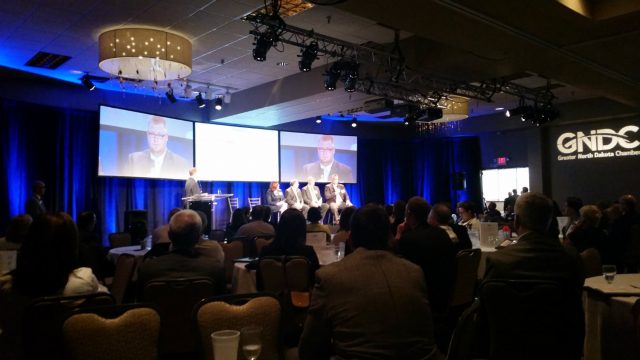Conservation Measure Proponents Get Laughs At Chamber Event

I’m at the Greater North Dakota Chamber of Commerce policy summit today (I’ll be on a panel in the afternoon about state spending) and the first discussion was about the conservation measure which aims to divert 5 percent of oil extraction revenues to a fund for conservation (read: a lot of money).
There were two supporters and two opponents on the panel, and it was an interesting discussion, but the conservationists didn’t win many friends in the crowd (at the end a text-in poll showed more than 80 percent opposition).
What amused me were a couple of laugh-out-loud moments from the discussion
First, Ducks Unlimited regional director Steve Adair (who is also the chair of the measure committee supporting the conservation measure) objected to comments about the spending mandate in the constitution made by the Chamber’s Jon Godfread (who is an opponent).
The measure requires that 75 percent of the revenues collected be allocated every year. Obviously, that’s worrisome. Such a mandate could very easily lead to indiscriminate spending as the Industrial Commission – which gets the ultimate decision about on spending – has its hand tied by the state constitution.
But Adair objected to the idea that it’s a spending mandate. He called it, to the amusement of the crowd, an “allocation” mandate. Because…that’s different? According to Adair it is, because instead of being spent the money could be “allocated” into a trust fund the measure also sets up.
I can say that not many in the room seem to be convinced.
The other funny moment came when a question submitted from the audience asked what level of oversight from the Legislature there would be the fund. Carmen Miller (who also works for Ducks Unlimited) said there would be oversight…because a report would have to be submitted to the Legislature about spending out of the fun.
This, too, got a good chuckle from the crowd.
This was a Chamber of Commerce event, and the Chamber of Commerce is opposed to this ballot measure. But there was a pretty good mix of North Dakota politics in the room – liberals and conservatives, etc. – and to the extent the audience can be used as a sample of the voting public, this measure probably doesn’t stand a very good chance.




